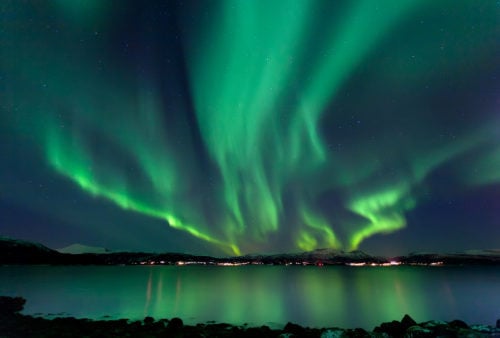If God chose, He might have created a safe, virtual universe, populated by virtual inhabitants, and could have spent eternity observing the virtual lives of His virtual creation.
But that’s not what happened. Instead, God created, with full awareness of the consequences, a real universe of incredible complexity. Space, matter, and time were brought into existence along with (most amazingly) living creatures. The study of God’s purposes in creating the universe is an exciting and rewarding subject that would be worthy of contemplation throughout eternity. But this much is already clear: a manifestation of infinite love prompted the Godhead to share the bliss and joy of existence with created beings (Isa. 45:18).
Mind-boggling Energy
Creation of matter required the output of a mind-boggling amount of energy and ingenuity that is, at this time, beyond human capacity to grasp. Everything that followed in the physical world—gravity, electromagnetic radiation, electricity, the strong forces between subatomic particles, the laws of physics and chemistry, the formation of stars and planets, the creation of living organisms—were all derived from the way by which energy was compressed, stabilized, and packaged into nearly 100 different types of atomic nuclei.
It is estimated that there are between 1050 to 1080 atoms in the observable universe. If these were only hydrogen atoms (the lightest of all elements), it would have required a minimum of 3.6 x 1039 to 3.6 x 1069 to calories of energy to create.((3.6 x 1039 is a scientific abbreviation for 36 followed by 38 zeros: 3,600,000,000,000,000,000,000,000,000,000,000,000,000. Likewise, 3.6 x 1069 is 36 followed by 68 zeros.)) (By comparison, the world’s total electricity consumption in the year 2005 was 1.4 x 1019 calories.)
While all matter came from the hand of the Creator, it was a gift to His creatures. God is not in matter. Nonetheless, the Creator is aware of every aspect of His creation, down to its smallest, subatomic level. The Lord knows the location and function of every one of His 1080 atoms. This much may be inferred from the reference Jesus made to God’s awareness of the smallest entities of the physical realm. “Are not two sparrows sold for a penny?” He said. “Yet not one of them will fall to the ground apart from the will of your Father. And even the very hairs of your head are all numbered” (Matt. 10:29, 30).*
After creating billions of diverse galaxies, each with billions of stars and untold numbers of inhabited planets, God decided to bring into existence a new order of being, created, we are told, in His own image (Gen. 1:26, 27)—which Ellen G. White suggests was both in outward resemblance and in character.((Ellen G. White, Patriarchs and Prophets, p. 45.)) In that capacity, humans could serve as new links between the Creator and His other creatures.
A space was allocated for a star (the sun) and planets in the “Milky Way” galaxy, where some 300 billion stars were already rotating in the fashion of a flat disc with a diameter of 100,000 light years. In a circular model of the Milky Way, with a diameter of 80 miles, Earth’s solar system would occupy a mere 2 millimeters.
Our Neighborhood
At the center of the solar system the Creator placed that massive star we call the sun, consisting of approximately 2 x 1027 metric tons of heated hydrogen, undergoing thermonuclear fusion to helium. This process results in a loss of 685 million tons of matter every second, yielding radiant energy and the emission of charged particles. (By comparison, the atomic blast of Hiroshima resulted from the destruction of only 1 gram of plutonium.) At the current rate of burning, the sun has enough fuel to last billions of years.
Closest to the sun, God placed four “terrestrial” planets: Mercury, Venus, Earth, and Mars—Earth being the largest. These were made primarily of silicate rocks. The four “outer” planets, much larger than the terrestrial ones, were composed of mostly gases. Jupiter and Saturn contained mostly cold hydrogen and helium, while Neptune and Uranus were made from ice, methane, and ammonia. Orbiting around these outer planets are some 150 moons, some of which are close in size to the terrestrial planets.
The combined mass of the planets and their moons is less than 1 percent of that of the sun, which holds all of these bodies under its gravitational control.
When the biblical account of the earth’s creation is combined with current astronomical data, a plausible scenario emerges in which the Creator likely brought into existence during Creation week the entire solar system (besides the earth, the sun, and the moon). If this was so, then it may be surmised further that what followed here during Creation week was but the first step in making the entire solar system habitable for humans.
The text, “Thus the heavens and the earth were completed in all their vast array” (Gen. 2:1), likely refers to planet Earth and its immediate surroundings.
The atmosphere of the freshly created earth was likely different from what it is now (see Gen. 2:5, 6). It was probably substantially richer in carbon dioxide, so that the luxurious verdure covering the pre-Flood planet could adequately be supported through photosynthesis.
The surface of the newly created earth was diversified with gently sloping hills and mountains, crisscrossed with rivers and lakes. There were no rocks, swamps, or deserts. The landscape everywhere on earth rivaled the most elaborately decorated grounds of palaces.((Ibid., p. 44.))
Breathtaking!
What followed the formation of Earth is nothing short of breathtaking. Using primarily the elements hydrogen, oxygen, nitrogen, carbon, phosphorus, and sulfur, the Creator called into existence structures of almost unimaginable complexity that could absorb solar or other forms of energy; and that could grow, divide, move about, and sense their environment. In short, living organisms.
To create the smallest living unit, the cell, required the construction of thousands of different types of exquisite, giant assemblies of atoms into the macromolecules of protein, nucleic acid, polysaccharides, and lipids. Some of these constructs were used as structural elements; others became specialized machines facilitating specific chemical changes.
The phenomenon of life is the net result of hundreds—or even thousands—of chemical changes within cells. A chemical change is the rearrangement of specific clusters of atoms (molecules) into new clusters. In live cells, chain reactions of chemical transformations occur continually. This is what separates living matter from inert, nonliving entities. While scientists are able to produce some of the macromolecules required for living matter, they are unable to start or restart the hundreds of separate, continuous chain reactions happening in each cell. This biological phenomenon is an incontrovertible proof that life has been created and could never have started spontaneously.((G. Javor, Evidences for Creation (Hagerstown, Md.: Review and Herald, 2005).)) The biochemical chain reactions, started in every cell of every organism at Creation, continue in an unbroken continuum through hundreds of generations to this day. Biologists have identified this law by saying that “life comes only from life.”
The Lord created two kinds of living organisms. Some creatures were endowed with a nervous system, giving them mobility and memory, and enabling them to sense their environment through sight, sound, and touch. Besides humans, the Creator brought unnumbered orders of creatures (large animals, birds, fish, insects, etc.) into existence.
The second category of newly created creatures was biorobotic—that is to say, they lacked a nervous system and are unaware of their own existence. Such organisms serve as receptors of solar energy, food, building material, and “decoration.” They also serve as integral components of the biosphere. They include plants, flowers, trees, and microorganisms.
Interdependence
All living organisms on earth belong to an integrated biosphere. The relationships among organisms may best be characterized as one of mutual support. None of the creatures on earth were designed to exist independently. For plants to grow, they need to capture the nitrogen gas from the air assisted by nitrogen-fixing microorganisms living in their roots.
The abundant solar energy bathing the earth is captured by plants and photosynthesizing algae. Plants use solar energy to manufacture carbohydrates from carbon dioxide out of the air and from water.
The Garden of Eden was to be a model to be imitated by the generations that would populate the earth. Instead of cities, much of the habitable portion of the earth was to be covered by gardens, where nature continually spoke to humanity of the Creator’s wisdom and love.((Ellen G. White, Education, p. 22.))
In the center of Eden was a very special tree, whose fruit was needed for humankind’s continuous existence. No organisms were created immortal (although microorganisms come close). Humans were to partake occasionally of the fruit of the tree of life to maintain life. How animals, fish, birds, and insects were to stave off death has not been disclosed in the Bible.
Experiments with tissue cultures indicate that healthy human and animal cells are capable of dividing only a certain number of times. For human cells, the maximum number of division translates to approximately 120 years of life. The reason for the finite number of cell division lies in the shortening of the ends of chromosomes, called the telomeric region, after each division.
Interestingly, we have an enzyme called telomerase that can restore telomers to their original size. Unfortunately, this enzyme becomes inactive shortly after birth. Only cancer cells, with capacity to divide unlimited times, contain active telomerase enzymes. Active telomerase does not cause cancer, but permits the corrupted genetic apparatus of the stricken cells to replicate.
Microorganisms contain circular chromosomes, and their cell division does not result in any shortening of genetic material. Theoretically they can divide an infinite number of times. But when a single cell divides into two daughter cells, strictly speaking, the cell’s existence is finished, as it morphs into its offspring.
A possible biological action of the fruit from the tree of life could have been to maintain telomerase activity indefinitely in adults. The long lifespan of the antediluvians could have been due, in large measure, to a residual telomerase activity inherited from Adam and Eve.
Similar molecular logic operates in the unnumbered thousands of different kinds of living organisms, containing, nevertheless, enough differences to preserve their individual identities. This flows from the closely integrated nature of the biosphere, as illustrated in the figure.
If it were possible to catalog the number of patentable inventions that were required for the creation of our biosphere, it would exceed by many orders of magnitude the combined numbers of inventions ever granted by all of the patent agencies of the world.
The ingenuity, resourcefulness, and sheer elegance of the way the living world is put together are beyond the human capacity to describe. Its contemplation forces the beholder to put their hand on the mouth (see Job 40:4); for whatever could be said would be unworthy and amount to a trivialization of this grand subject. Silence here is eloquence.((Ellen G. White, Fundamentals of Christian Education, pp. 179, 180.))
Is it possible ever to doubt the goodness, love, and wisdom of the Being responsible for this vast, magnificent, and “very good” creation? The answer can only be a resounding NO!
We join the psalmist when he says: “How great are your works, O Lord, how profound your thoughts!” (Ps. 92:5). “Many, O Lord my God, are the wonders you have done. The things you planned for us no one can recount to you; were I to speak and tell of them, they would be too many to declare” (Ps. 40:5).
*All Scripture references are from the New International Version.
George T. Javor taught at Loma Linda University School of Medicine in the Biochemistry Department until his retirement in 2006. He lives in New Leipzig, North Dakota.
This article originally appeared on adventistworld.org in October 2009.

